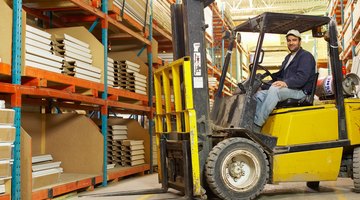How to Fill Forklift Cylinders
A large number of industrial powered lift trucks, also known as forklifts, are powered by liquid propane. Many locations will have cylinders delivered to their facility, and when a forklift runs out of fuel, the cylinders are changed out. In other instances, facilities will have refueling capabilities on site.

While this is a very straightforward process, some training and caution is required as you will be dealing with a highly flammable substance.
Things You Will Need
- Supply of propane
- Safety equipment
-
Put on all PPE (personal protective equipment) prior to beginning this task. Liquid propane is extremely cold and can cause severe burns if it comes into contact with your skin. Always wear thick leather gloves to protect your hands. You also will need to wear eye protection in the form of goggles or other approved eyewear. A full face shield is also recommended. You should also make certain a fire extinguisher is located nearby before beginning the refueling process.
-
Turn off the forklift and extinguish any cigarettes or open flames in the area. Locate the fill valve on the cylinder and remove the plastic protective cap. Attach the fill line to the fill valve, making certain the connection is secure. Once the fill line is in place, carefully open the bleed valve. This will be a small round nob on the cylinder and is normally brass or brass colored. There may be a hissing sound when the valve is open, this is normal as long as only air is being vented and not propane.
-
Open the fill valve on the fill line slowly. When you are certain there are no leaks around the connection to the tank, you can open the valve more fully. You should be able to hear the propane entering the tank. Watch the bleeder valve during the fueling process; never leave the tank unattended when refueling. When the tank is full, you will see a spray of white propane gas coming from the bleeder valve. Turn off the fill valve completely, then close the bleeder valve. Very slowly remove the fill line from the tank. There may be excess gas caught in the coupling which will be expelled when the seal is broken, but it should be only a small amount of gas and is normal. Replace the protective cap on the fill valve and double check to be certain all valves are fully closed. The tank is now full and ready to use.
Tip
Complete a quick visual inspection of the tank before refueling. If the tank appears damaged, have it checked before refueling.
References
Writer Bio
Tom Raley is a freelance writer living in central Arkansas. He has been writing for more than 20 years and his short stories and articles have appeared in more than 25 different publications including P.I. Magazine, Pulsar and Writer's Digest.
Photo Credits
- Photos.com/Photos.com/Getty Images
- Photos.com/Photos.com/Getty Images
More Articles



